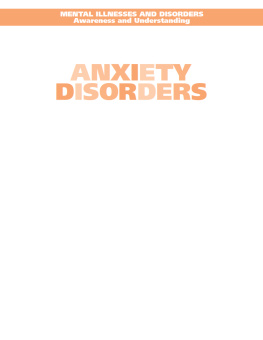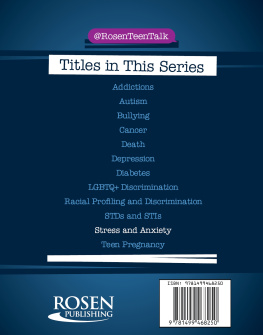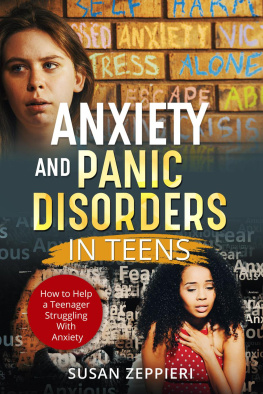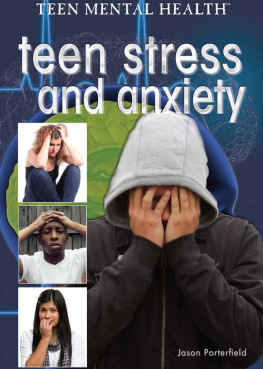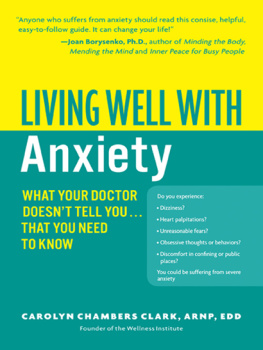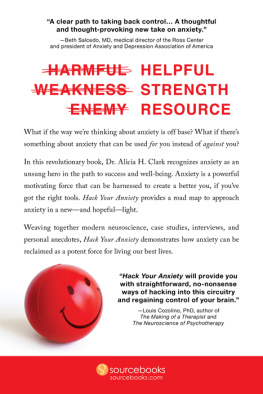

Thank you to Kerri Pedrick for her assistance and advice. More Than Stress is dedicated to the millions of people who struggle daily with anxiety disorders, the families whose lives are deeply affected by anxiety disorders in their loved ones, and the doctors, researchers, and scientists who dedicate their lives to helping patients with anxiety disorders and finding more effective treatments.
Copyright 2023 by Cherry Pedrick and Bruce M. Hyman
All rights reserved. International copyright secured. No part of this book may be reproduced, stored in a retrieval system, or transmitted in any form or by any meanselectronic, mechanical, photocopying, recording, or otherwisewithout the prior written permission of Lerner Publishing Group, Inc., except for the inclusion of brief quotations in an acknowledged review .
Twenty-First Century Books
An imprint of Lerner Publishing Group, Inc.
241 First Avenue North
Minneapolis, MN 55401 USA
For reading levels and more information, look up this title at www.lernerbooks.com .
Diagrams on pages 8, 12, 21, 36 by Laura K. Westlund.
Main body text set in Conduit ITC Std.
Typeface provided by International Typeface Corp.
Library of Congress Cataloging-in-Publication Data
Names: Pedrick, Cherry, author . | Hyman, Bruce M., author.
Title: More than stres s : understanding anxiety disorders / Cherry Pedrick, R.N., Bruce M. Hyman, Ph.D.
Description: Minneapoli s : Twenty-First Century Books, [2023 ] | Series: Healthy living librar y | Includes bibliographical references and index . | Audience: Ages 111 8 | Audience: Grades 101 2 | Summary: Many teens struggle with anxiety disorders, the symptoms of which include elevated stress hormone levels, depression, and heart problems. The prevalence of anxiety disorders among teens today makes this a timely, informative, and helpful book for readers. Readers will learn about the causes, symptoms, and diagnosis of anxiety disorders as well as coping strategies and treatments. Resources for identifying, managing, and treating anxiety disorders are provided in the text Provided by publisher.
Identifiers: LCCN 2021040627 (print ) | LCCN 2021040628 (ebook ) | ISBN 781541588936 (library binding ) | ISBN 781728419114 (ebook)
Subjects: LCSH: Obsessive-compulsive disorderJuvenile literature.
Classification: LCC RC533 .P43 2023 (print ) | LCC RC533 (ebook ) | DDC 616.85/227dc23
LC record available at https://lccn.loc.gov/2021040627
LC ebook record available at https://lccn.loc.gov/2021040628
Manufactured in the United States of America
1-47456-48021-2/25/2022
Contents
Introduction
Living with Anxiety
Chapter One
Panic and Fear
Chapter Two
Rituals , Trauma , and Worry
Chapter Three
Treatment Options
Chapter Four
Stress Management
Conclusion
You Can Manage an Anxiety Disorder
Introduction
Living with Anxiety
W hen someone uses the term anxiety or shares that they are feeling anxious, what do they mean? Anxiety is a word often used to describe a specific worry. This type of anxiety tends to focus on a specific event in the near future. For example, someone may say that they are feeling anxious about their upcoming performance in a play or asking their crush out on a date. Generally, when the word anxiety is used this way, the person speaking is referring to this common feeling of nervous anticipation.
Anxiety can also mean something different. When someone talks about experiencing a clinical anxiety disorder, they are talking about a specific category of mental health disorders that causes a lot of distress and can affect many facets of everyday life. In this book, we will discuss some of the many recognized clinical anxiety disorders and the effects that they have on peoples daily lives. Many people struggle with clinical anxiety disorders every day, and the different types of disorders and their symptoms can look different on different people. Its important to talk about anxiety disorders to raise awareness and decrease stigma around them. People experience anxiety disorders for many reasons, and with treatment many enjoy life with few or no symptoms.
So what is clinical anxiety? Some people describe this anxiety as an intense fear. Fear is a normal, healthy part of the human experience. It is an appropriate response to threats, challenges, and potential loss. Fear encourages you to study harder for tests, reminds you to get college applications in on time, and makes you take reasonable safety precautions. Worry stemming from such fears is helpful and helps us succeed, argues Luana Marques, an associate professor of psychiatry at Harvard Medical School and president of the Anxiety and Depression Association of America. Worry is a way for your brain to handle problems in order to keep you safe, she explains. Its only when we get stuck thinking about a problem that worry stops being functional. When fear is out of proportion to the threats at hand and causes excessive worry about unlikely future events, the result is anxiety. Many people experience anxiety from time to time, especially when they are under stress from work, school, or relationship troubles. When anxiety persists and interferes with daily life, a person may be diagnosed with an anxiety disorder.
Fear vs. Anxiety
Fear is a response to a well-defined danger, a specific object, or a particular situation. Think of it as the brains natural alarm system that goes off when there is a present threat. The level of fear one experiences is in proportion to the actual threat. Common fears include illness, job loss, family separation, physical harm, poverty, and death. Anxiety is an excessive, out-of-proportion response to a hypothetical, future-oriented danger. Someone experiencing anxiety may not be able to describe the actual threat. Often there might be just a sense of overwhelming panic that something bad will happen. Other people experiencing anxiety may be able to pinpoint a specific circumstance or event they fear. As the event draws near, or as they think about it often, they may experience even more severe anxiety. The event does not have to be something occurring in the near future. For example, a nine-year-old may experience a racing heart and intense fear when they think about whether they will pass their drivers test, even though their drivers test will not occur for many years. Someone else may feel anxiety at the thought that they and their loved ones will someday die of old age, even though that event may be years away.
Anxiety affects people on four levels. There can be many physical symptoms, including rapid heart rate, stomach discomfort (butterflies), trembling, nausea, muscle tightness, sweating, vomiting, diarrhea, and shortness of breath. Mental symptoms include uneasiness, worry, intrusive thoughts, confusion, poor concentration, and a sense of helplessness. Emotionally, anxiety might look like feelings of panic, embarrassment, or rejection. Anxiety may also manifest in behaviors, such as avoiding particular objects, places, or situations. As with obsessive-compulsive disorder (OCD), someone may perform unnecessary rituals. Recovery often involves treatment of the physical, mental, emotional, and behavioral aspects of the symptoms. Some people may experience anxiety on only one of the four levels or more intensely on one of the levels. When this occurs, recovery and treatment will focus on alleviating the symptoms that are causing distress.
Next page

